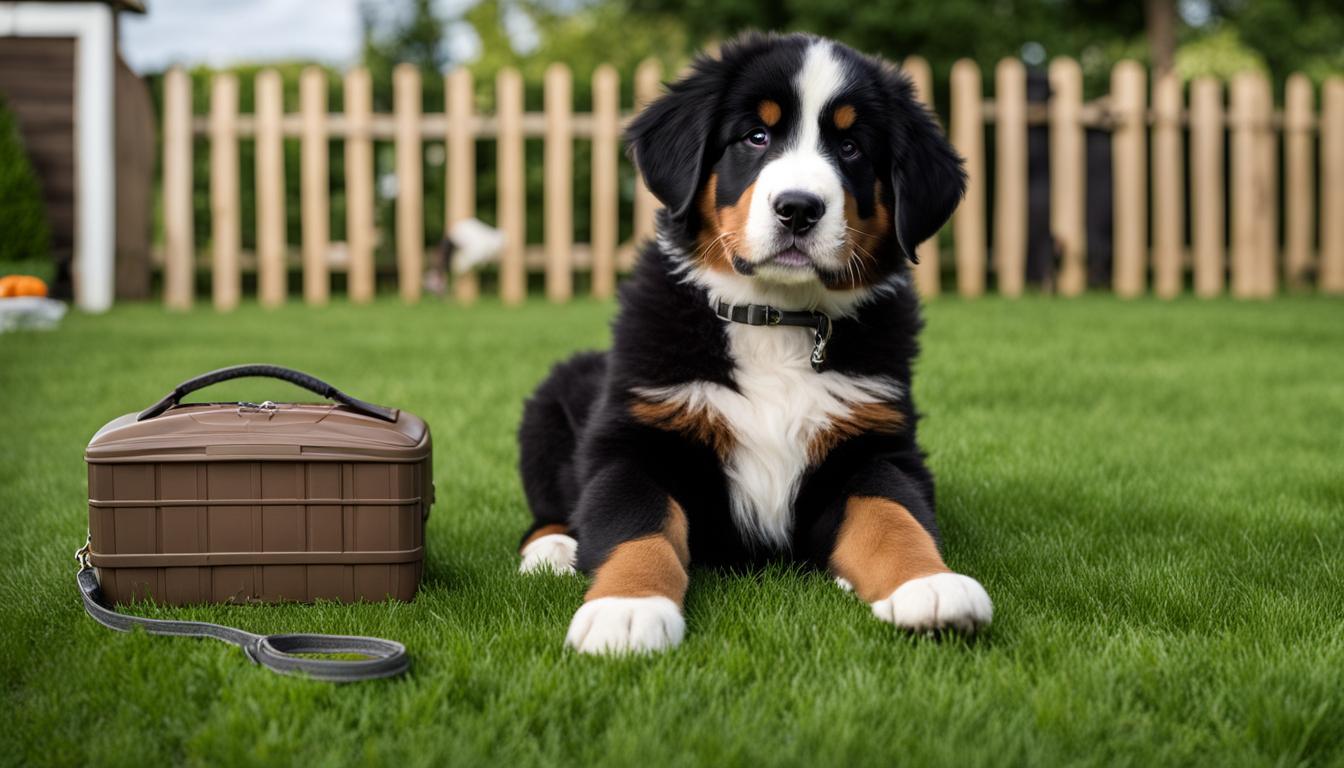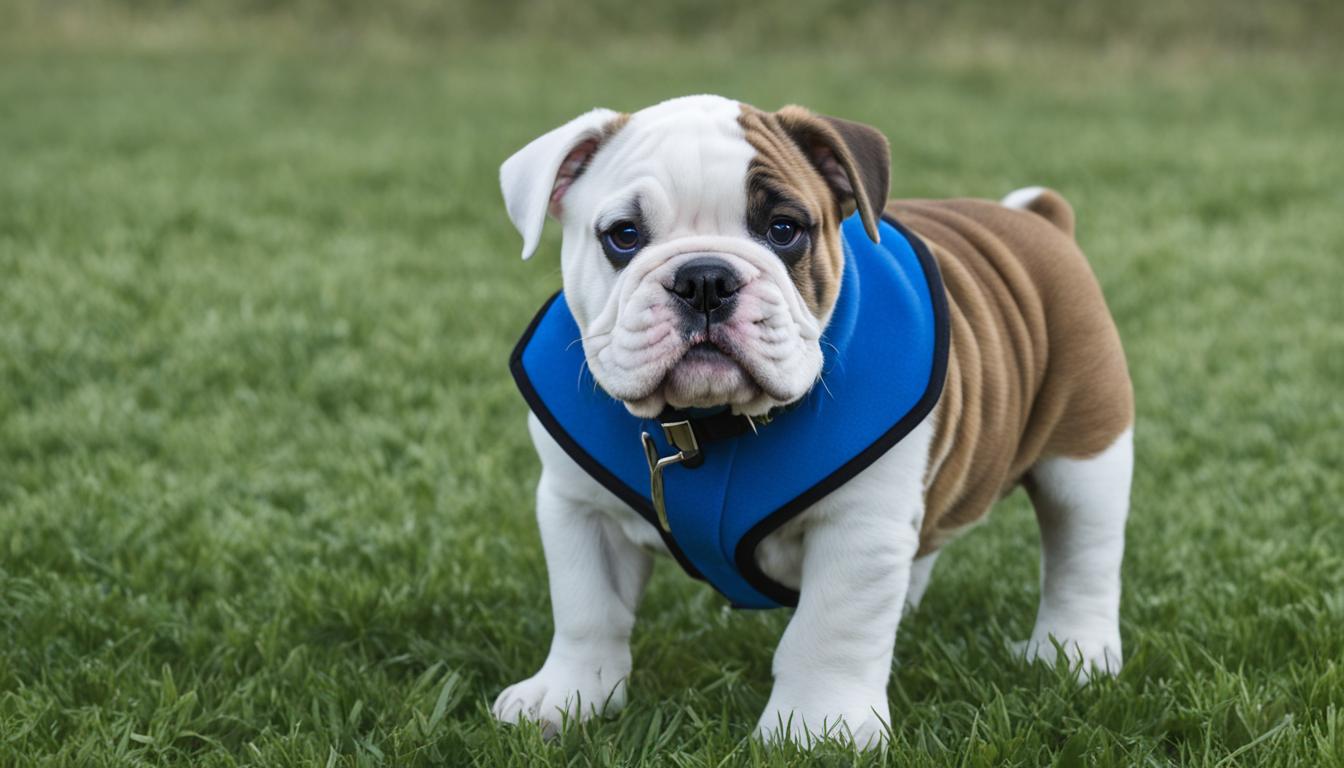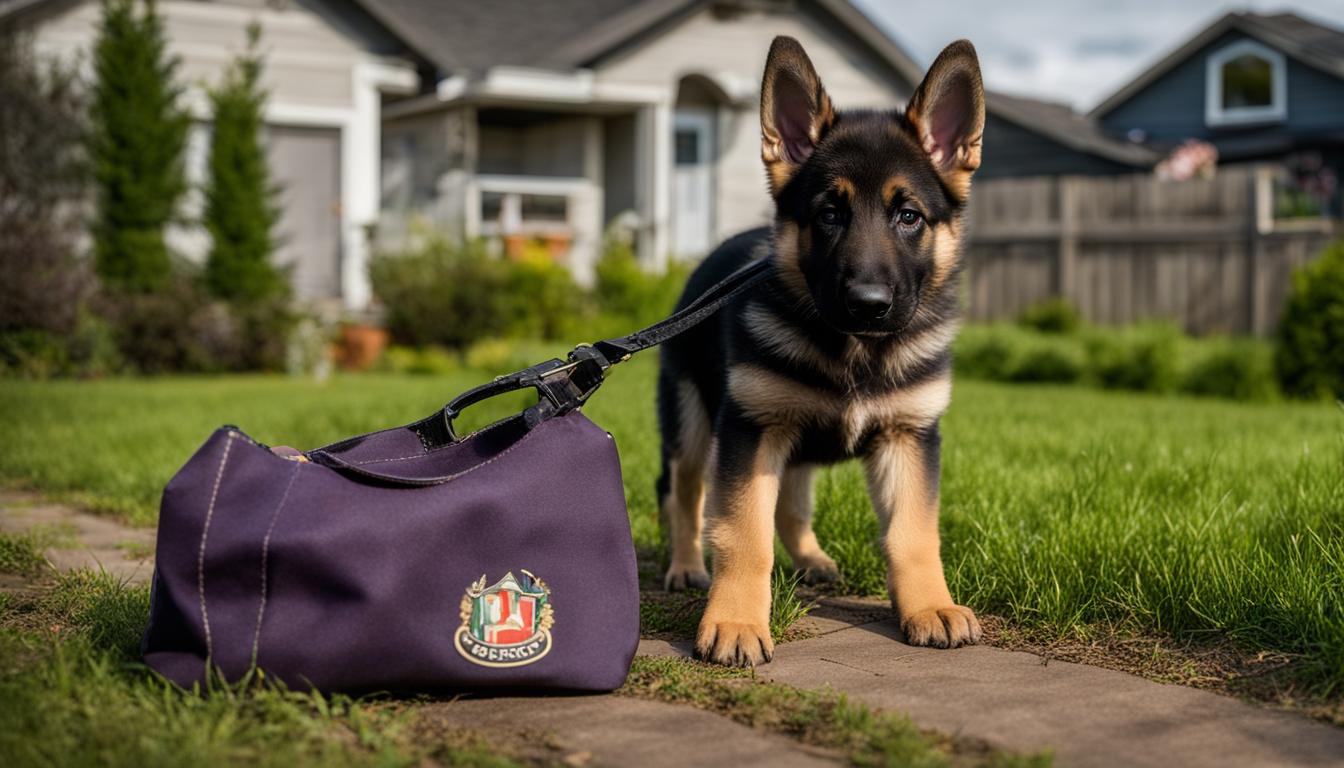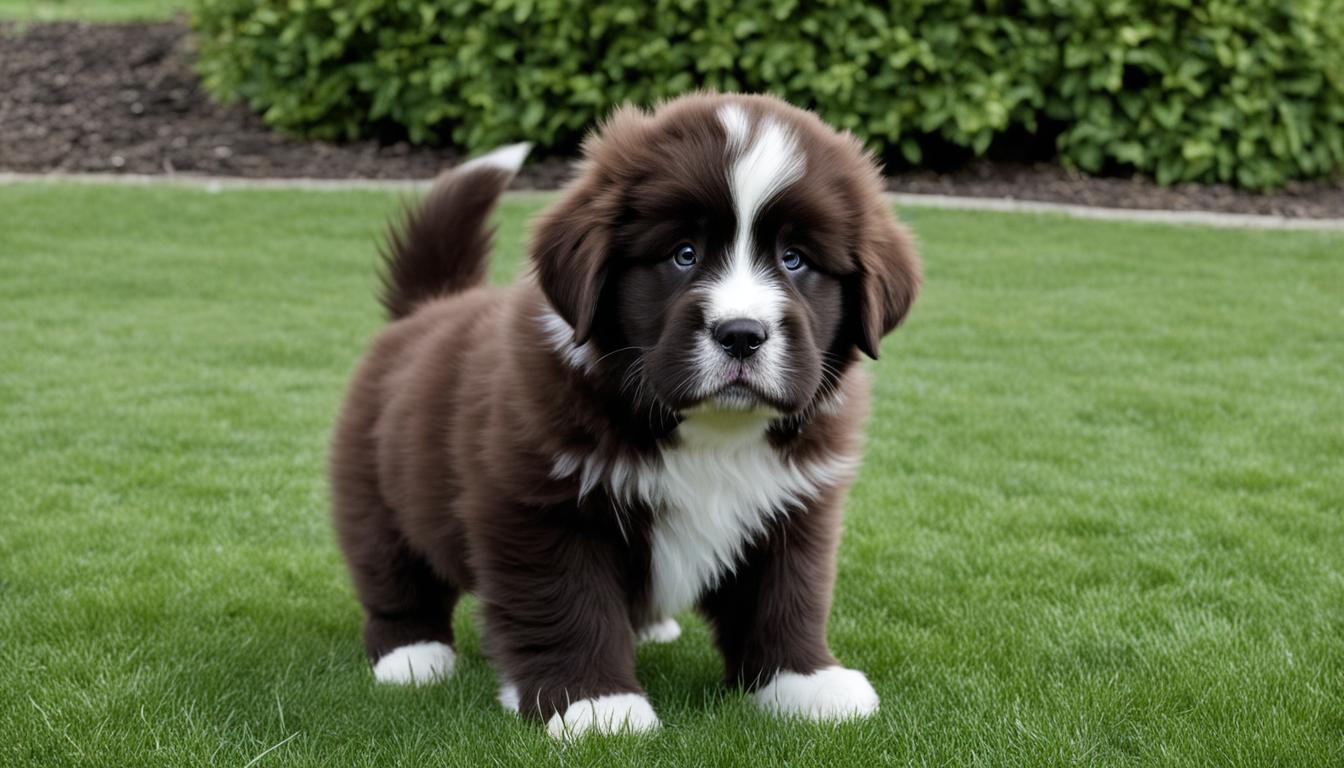Embarking on the journey of potty training a Bernese Mountain Dog puppy is a pivotal aspect of responsible pet ownership. It’s an investment in creating a harmonious living situation and an opportunity to establish good habits early on.
As you set forth with this guide, remember that patience and consistency form the cornerstone of effective housebreaking. Begin your training experience equipped with (not only a bounty of treats and supplies but also) an enthusiastic spirit, ready to celebrate the small victories with your furry friend.
Potty training shouldn’t be a daunting task—it’s a natural step in growing up for your Bernese Mountain Dog puppy. By following a step-by-step process, you’ll instill a sense of routine and expectation, helping your puppy understand and meet your household standards.
Let’s dive in and transform this rite of passage into a rewarding experience for both you and your pup.
What Are The Benefits of Potty Training Your Bernese Mountain Dog Puppy?
When it comes to raising a happy and healthy canine companion, housebreaking is a linchpin for cultivating a clean living environment. Potty training your Bernese Mountain Dog puppy not only promotes a sense of hygiene but also lays the groundwork for a harmonious relationship between you and your furry friend.
Potty training is imperative for creating positive experiences that enrich the bond you share with your puppy. By steering this training towards success, you foster a deeper connection and assure your pet of the trust you place in them.
The benefits of such training go beyond the housebreaking routine; they underpin the dynamics of interplay and understanding between you both.
Remember, a Bernese Mountain Dog puppy thrives on routine and clear expectations, making the learning process a golden opportunity to set up the stepping stones for a lifetime of good habits.
- Maintains a pristine home free of accidents
- Encourages proper hygiene and health for your puppy
- Strengthens the emotional bond through consistent, positive reinforcement
- Creates a structured routine that fosters security and confidence
In essence, housebreaking your Bernese Mountain Dog puppy is more than just an obedience drill; it’s an investment in a happy, respectful, and positive living experience for both of you.
How to Potty Train a Bernese Mountain Dog Puppy (Step-by-Step)
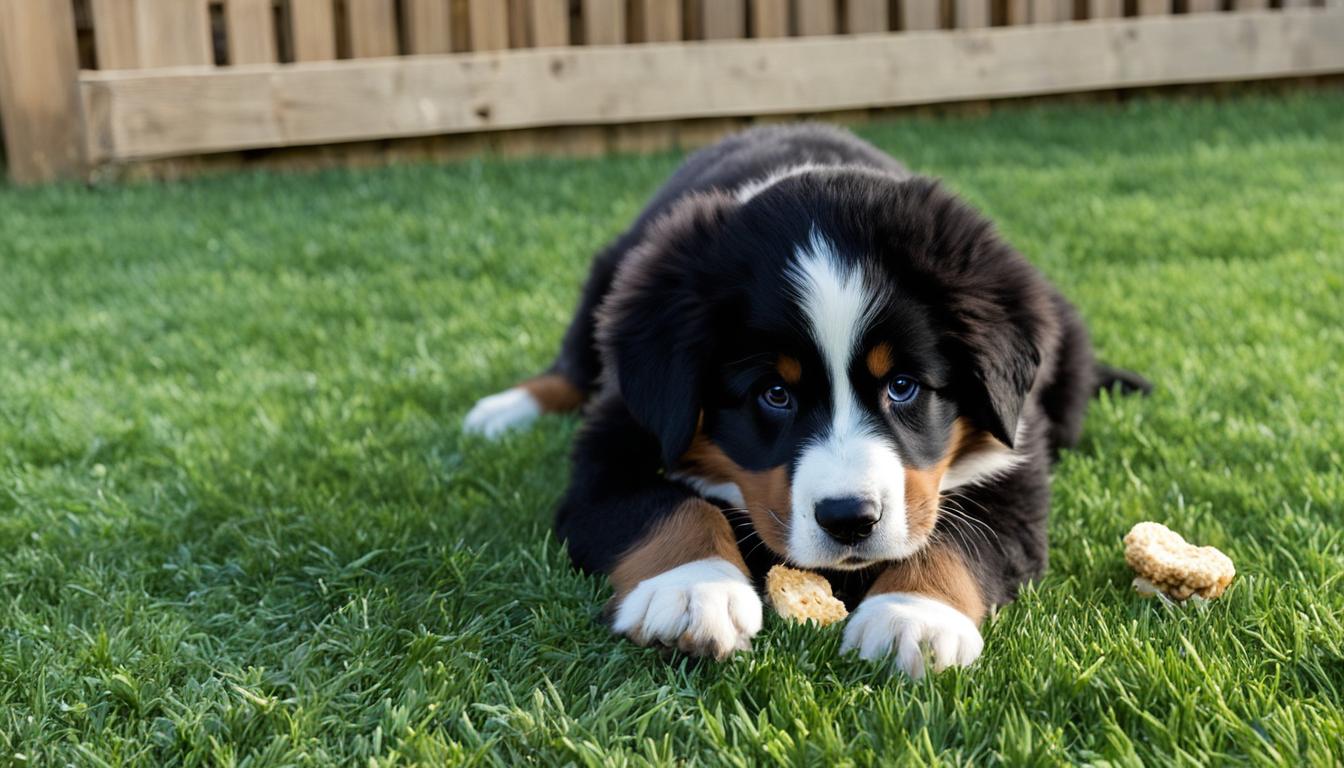
Embarking on the journey of potty training your Bernese Mountain Dog puppy requires a blend of patient training, a consistent routine, and an understanding of your puppy’s needs. You’ll be setting the stage for a lifetime of good habits, so let’s step into your puppy’s paw prints and follow the path to successful potty training.
Step 1: Master The Basics of Potty Training a Puppy
This potty-training voyage begins with the basics. It’s important to gear up for some dedicated, positive, and patient training sessions. You are not only teaching your puppy where to go to the bathroom but also instilling trust and understanding between you and your furry friend.
Step 2: Choose The Designated Puppy Potty Area
Identification of a puppy potty area is crucial. This spot will become your puppy’s go-to place to relieve themselves. The area should be easily accessible, safe, and calm to encourage your puppy to feel comfortable using it.
Step 3: Set a Potty Break Schedule
Creating a potty break schedule helps your Bernese Mountain Dog puppy to develop bodily awareness and control. Regularly scheduled outings will make potty training more predictable and manageable for both you and your puppy.
Step 4: Look for Visual Cues Such as Sniffing, Circling or Whining
Pay attention to your puppy’s behavioral cues. Quick detection of sniffing, circling, or whining can prevent accidents and reinforce the idea that outside is the place to go.
Step 5: Take Your Puppy Out to The Designated Potty Area Frequently
Stay dedicated to taking your puppy out often, especially after meals, waking up, and during playtime. Frequent visits to the puppy potty area will cement the right location in your puppy’s mind.
Step 6: Use a Leash and Collar or Harness to Take The Puppy Outside
Equipping your puppy with a comfortable leash and collar or harness not only ensures safety but also helps maintain control as you guide them to the potty area.
Step 7: Avoid Accidents at All Costs
While accidents can happen, it’s vital to do your best to prevent them. This means not waiting too long between potty breaks and being vigilant about your puppy’s signals.
Step 8: Clean up Any Accidents Thoroughly With an Enzymatic Cleaner
If an accident does occur, clean it up thoroughly with an enzymatic cleaner to eliminate odors and discourage your puppy from revisiting the spot for the same purpose.
Step 9: Choose a Specific Word to Use Consistently When Taking Your Bernese Mountain Dog Puppy Outside to Potty
Picking a specific word or phrase to signal potty time, and using it consistently, will help your puppy understand what is expected of them quicker.
Step 10: Stick With a Routine
Adherence to a consistent routine is key for potty training success. It helps your puppy internalize their schedule and expectations, leading to better behavior and less stress for everyone.
Step 11: Confine The Puppy When You Are Unable to Supervise Them
Using a crate or a puppy-proofed area when you cannot supervise your puppy can prevent accidents and encourage them to hold their bladder until it’s time to go outside.
Step 12: Stay Consistent and Patient for Successful Potty Training
Even when progress seems slow, maintaining a consistent and patient approach to potty training will yield the best results. Every puppy learns at its own pace, and your steady presence will support their growth.
Step 13: Focus on Praising Your Puppy for Getting It Right
Don’t skimp on the praising when your puppy does their business in the right spot. A positive affirmation can go a long way in reinforcing good behavior.
Step 14: Gradually Increase The Time Between Potty Breaks
As your puppy grows, they will develop a larger bladder capacity. You can start extending the time between trips outside, which helps them learn to hold it for longer periods and adapt to a more adult bathroom schedule.
With these steps, you’re well on your way to securing a happy, hygienic home life for you and your Bernese Mountain Dog puppy. Remember, potty training is a foundation of care and companionship that will serve both of you in the years to come. Good luck, and enjoy every step of this rewarding experience!
Equipments You Need Before Starting Potty Training a Bernese Mountain Dog Puppy
Before you embark on the journey of potty training your Bernese Mountain Dog puppy, it’s essential to have the right equipment on hand. Effective crate training depends critically on the right size crate, while potty bells provide a unique way for your puppy to communicate. Remember, positive reinforcement is crucial in encouraging desirable behavior, so keeping treats available is vital. Below, find a guide to help you gather everything you need for successful potty training.
- A properly sized crate: Make sure your puppy can stand, turn around, and lie down comfortably.
- Potty bells: Hang them by the door you use to take your puppy outside, teaching them to signal you.
- High-value treats: Choose treats that your puppy loves to offer as rewards for successful potty breaks.
Understanding these tools will ease the training process:
| Equipment | Function | Training Benefits |
|---|---|---|
| Properly Sized Crate | Encourages natural instinct to not soil sleeping areas | Supports crate training by providing a designated space for your puppy |
| Potty Bells | Communication tool for signaling need to go outside | Empowers your puppy to alert you, preventing accidents |
| High-value Treats | Reward for correct behavior | Enhances positive reinforcement, reinforcing good potty habits |
Remember, patience and consistency with these tools will pave the way to a well-trained companion. Happy training!
Indoor Potty Training Vs. Outdoor Potty Training

As a responsible pet owner, understanding the nuances of indoor training compared to outdoor potty methods is fundamental.
If your living situation limits immediate access to the outdoors, or if you’re often away and cannot consistently escort your Bernese Mountain Dog puppy outside, puppy pads may offer a practical solution for indoor training.
Let’s delve into the benefits and considerations of each approach to help you establish the most effective designated potty area for your furry friend.
| Indoor Training with Puppy Pads | Outdoor Potty Training |
|---|---|
| Advantageous for high-rise apartment living | Encourages natural behavior to eliminate outdoors |
| Convenient during inclement weather | Reduces the likelihood of indoor accidents |
| Requires consistent replacement and cleanup | Strengthens routine with regular outside visits |
| May delay transition to outdoor elimination | Promotes more substantial bladder control over time |
| Useful for puppies in vaccination process | Allows for socialization and exercise during potty breaks |
An effective indoor potty training space underscores convenience but necessitates due diligence in transitioning to outdoor habits, if that’s your goal. Meanwhile, consistent outdoor training from the start aligns with a puppy’s instinct to avoid soiling their living space and presents a clear, straightforward routine. Whichever method you opt for, patience and positive reinforcement are paramount in nurturing a well-trained pup.
Crate Training Vs. Pad Training a Bernese Mountain Dog Puppy
When it comes to house training techniques, one of the most significant decisions you’ll make as a pet owner is whether to use crate training or pad training for your Bernese Mountain Dog puppy.
Both methods come with their respective crate training benefits and considerations for pad training. It’s crucial to understand the implications of each to make the best choice for your furry companion.
Crate training capitalizes on a dog’s desire to keep their resting area clean, thus preventing unwanted accidents and fostering good bladder control habits. This method aligns with a puppy’s instinctual behavior and can set a solid foundation for future training.
On the flip side, pad training may suit pet owners who live in high-rise apartments or lack immediate access to an outdoor space. Pads can offer a designated indoor spot for your pup to relieve themselves without the need for frequent outdoor trips.
| Crate Training | Pad Training |
|---|---|
| Encourages bladder control | Convenient for indoor settings |
| Can reduce nighttime awakenings | May help when the weather is bad |
| Assists in preventing destructive behavior | Useful for dogs with mobility issues |
| Facilitates a safe space for the puppy | Can be challenging to transition to outdoor training |
| Makes travel with your dog easier | Requires consistent cleaning and pad changes |
Be mindful that while pad training might initially be convenient, it can potentially hinder the process of transitioning to exclusively outdoor elimination. Crate training, conversely, generally leads to better long-term habits and easier maintenance.
Your living situation, schedule, and your pet’s specific needs should guide your decision. No matter which house training techniques you choose, remember that patience and consistency are vital to successfully potty train your Bernese Mountain Dog puppy.
Frequently Asked Questions About Potty Training a Bernese Mountain Dog Puppy

Potty training your Bernese Mountain Dog puppy involves recognizing behavioral cues and providing frequent potty breaks. It’s a process guided by patience and reward-based training. To help you navigate through this journey, we’ve compiled a list of common questions to ensure a smooth housebreaking experience for both you and your puppy.
How Long Does It Typically Take to Potty Train a Bernese Mountain Dog Puppy?
It generally takes a few months of dedicated training. Consistency in routine and responding to your puppy’s needs are key. Remember, patience is crucial during this formative time.
What to Do if Your Bernese Mountain Dog Puppy Won’t Pee Outside The House?
Consider your pup’s comfort and any potential stress factors that may be affecting them. Stay calm and provide encouragement. If the issue persists, a vet check may be necessary.
Should You Use Treats When House Training a Bernese Mountain Dog Puppy?
Absolutely. High-value treats can significantly encourage your puppy when used correctly in reward-based training.
Is It Better to Use Puppy Pads or Go Straight to Outdoor Potty Training for a Bernese Mountain Dog Puppy?
While puppy pads can be practical in certain living situations, outdoor potty training is generally recommended for establishing long-term housebreaking habits.
What Should I Do if My Bernese Mountain Dog Puppy Does Not Seem to Be Learning to Potty Train Correctly?
Reassess your training approach for consistency. Gradual reinforcement and adapting to the puppy’s learning pace can result in better outcomes.
What Should I Do if My Bernese Mountain Dog Puppy Starts Accidents in The House?
Maintain consistency in your response and clean up any accidents thoroughly. Reiterating the training routines can get your puppy back on track.
What Are Some Common Mistakes That Are Made When Potty Training a Bernese Mountain Dog Puppy?
A common error is lack of consistency and negative reinforcement, which can delay progress and stress your pet.
What Are Some Potential Consequences of Not Potty Training a Bernese Mountain Dog Puppy?
Without proper training, your home may suffer damage and both you and your puppy could experience increased stress.
What Can I Do to Help My Bernese Mountain Dog Puppy Feel More Comfortable Going Potty Outside?
Create a positive environment and gradually introduce them to the outdoors. Association with comfort and rewards can alleviate discomfort.
How Old Does My Bernese Mountain Dog Need to Be Before I Can Start Potty Training?
The ideal age to begin is around 8 weeks. Starting early can lead to more effective training.
How Often Should I Take My Bernese Mountain Dog Puppy Outside to Go Potty During The Day?
Puppies typically need breaks every 1-2 hours. Pay attention to their cues to adjust frequency as needed.
What Should I Do if My Bernese Mountain Dog Puppy Has an Accident Inside During Potty Training?
Don’t punish. Clean the area well to remove odors and prevent repeat incidents, and then consistently continue with your training strategies.
Last Thoughts on Bernese Mountain Dog Puppy Potty Training
As we wrap up the journey of potty training your Bernese Mountain Dog puppy, bear in mind the breed’s quick-witted nature and sensitivity. Your dedication to creating a gentle and supportive environment is crucial for house training success.
Employing patient training techniques and celebrating every milestone with positive reinforcement will pave the way for a well-adjusted and disciplined companion. Remember, handling the occasional slip-up with grace and seeing it as part of the learning curve will only make both you and your furry friend stronger.
Maintaining a regular schedule and recognizing the value of consistency in training are paramount. Not every day will be perfect, but with each small victory, you’re contributing to a lifetime of good habits and mutual respect.
Be generous with praise and treats to reinforce their good behavior, because positive experiences are foundational blocks for potty training any puppy, especially those of the intelligent Bernese Mountain Dog breed.
Ultimately, the goal isn’t just about reducing accidents inside the house but nurturing a relationship that thrives on trust and understanding. With unwavering commitment and a loving approach to guidance, you’ll create a harmonious living space for both you and your beloved Bernese Mountain Dog.
So, stay the course, appreciate the process, and look forward to many joyous years with your well-trained partner at your side.

